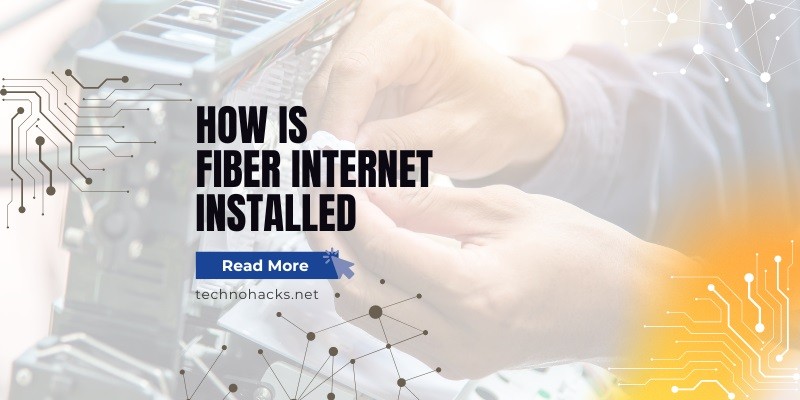Last Updated on May 5, 2025 by Jim C.
Fiber internet has become increasingly popular due to its superior speed and reliability compared to traditional broadband connections. However, the installation process for fiber internet differs from that of cable or DSL. This article will walk you through the step-by-step process of fiber internet installation, from initial planning to final setup.
Planning and Preparation
The fiber installation process begins with thorough planning and preparation. This phase involves several key steps:
Initial Consultation and Serviceability Check
Before any physical work begins, the internet service provider (ISP) conducts an initial consultation to assess the customer’s needs and check service availability. This typically involves:
- Evaluating the customer’s Internet requirements
- Checking if fiber service is available in the area
- Reviewing the property layout and existing infrastructure
If the property is already equipped for fiber service, installation can often proceed quickly. For buildings near existing fiber networks, a site survey may be conducted to estimate the time and resources needed to extend service.
Scheduling the Installation
Once serviceability is confirmed, the ISP schedules an installation appointment. Customers should prepare for the technician’s visit by:
- Identifying the desired location for internet equipment
- Ensuring access to all necessary areas of the property
- Clearing space for the technician to work
The installation process typically takes 1-2 hours, though this can vary depending on the complexity of the setup.
The Installation Process
Step 1: Fiber Cable Installation
The first major step in the installation process is running the fiber optic cable from the street to the home. This can be done in two ways:
- Aerial installation: The fiber cable is run along existing utility poles.
- Underground installation: A thin trench is dug to lay the fiber cable underground.
In both cases, professional crews take care to minimize disruption to the property.
Step 2: Installing the Optical Network Terminal (ONT)
Once the fiber cable reaches the home, the technician installs the Optical Network Terminal (ONT). The ONT is a crucial piece of equipment that converts the light signals from the fiber optic cable into electrical signals that can be used by your devices. The ONT is typically installed:
- On an exterior wall of the home
- In the Garage
- In a utility closet
The exact location depends on the home’s layout and the customer’s preferences.
Step 3: Connecting the Router
After the ONT is in place, the technician connects it to a fiber-compatible router. This router distributes the internet signal throughout the home, allowing multiple devices to connect. Some key points about the router setup:
- Many ISPs provide a combined ONT and router device
- Customers may have the option to use their own router if it’s compatible with fiber internet
- The router is typically connected to the ONT via an Ethernet cable
Step 4: Interior Wiring
Depending on the home’s layout and the customer’s needs, additional interior wiring may be necessary. This could involve:
- Running Ethernet cables to specific rooms for wired connections
- Installing additional access points for better Wi-Fi coverage in large homes
If extensive interior wiring is required, it may incur additional installation fees.
Step 5: Testing and Activation
Once all equipment is in place, the technician conducts thorough testing to ensure everything is functioning correctly. This includes:
- Verifying signal strength and stability
- Testing internet speeds
- Ensuring all equipment is properly configured
After successful testing, the technician activates the service, and the customer can begin using their new fiber internet connection.
Equipment Needed for Fiber Internet
To fully understand the installation process, it’s helpful to know the key equipment involved:
- Fiber Optic Cable: The core infrastructure that transmits data using light signals.
- Clamshell: A protective cover that safely connects the outside fiber line to interior cables.
- Optical Network Terminal (ONT): Converts light signals from the fiber cable into electrical signals usable by home devices.
- Fiber-Ready Router: Distributes the internet signal throughout the home, enabling Wi-Fi connectivity.
- Ethernet Cables: Used to connect the ONT to the router and potentially to other devices for wired connections.
Most of this equipment is provided and installed by the ISP as part of the service setup.
Post-Installation Support
After the installation is complete, many ISPs offer ongoing support to ensure customer satisfaction:
- Some providers assign a dedicated client success manager to assist with any issues or questions
- Technical support is typically available for troubleshooting connection problems
- Customers may have the option to upgrade their service or add features like static IP addresses
Cost Considerations
The cost of fiber internet installation can vary depending on several factors:
- Many ISPs offer free or discounted installation for new customers
- Standard installation fees typically range from $50 to $100
- More complex installations requiring extensive wiring or construction may incur additional costs
Customers should discuss potential fees with their ISP before scheduling installation.
Conclusion
Fiber internet installation is a multi-step process that requires specialized equipment and expertise. While it may seem complex, most of the work is handled by trained technicians, making the process relatively smooth for the customer. The result is a high-speed, reliable internet connection that can significantly enhance online experiences for both work and leisure.

